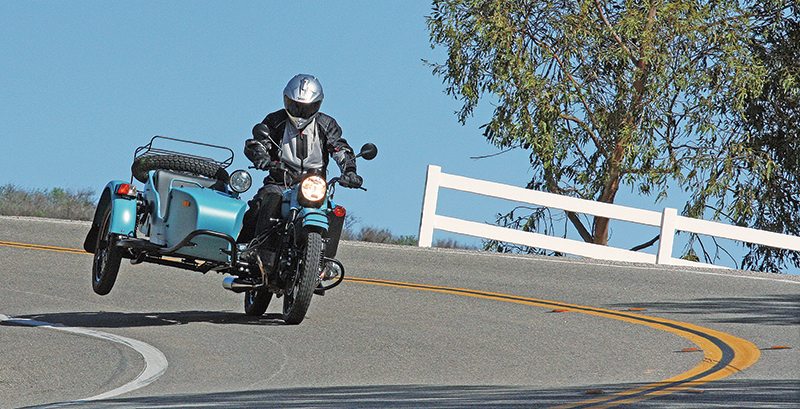
The last time we tested a Ural sidecar rig (June 2012), it was like a carny ride from the 1960s. That basic Ural T was a thrill to drive around the city or suburbia, fling around in the local canyons or take on backroad day trips, and riding in the chair was exhilarating yet comfortable enough for a nap. Neighbors I had never met asked for rides, it’s retro styling drew waves and thumbs-up from kids, cops and grandmas, and wide-eyed passersby had questions at every stop. Even with a passenger in the sidecar, there was plenty of room for a weeks’ worth of gear in the large trunk, and driven solo, several hundred pounds of camping stuff and spares could be loaded in the sidecar. At $9,999, the bang for the buck was remarkable.
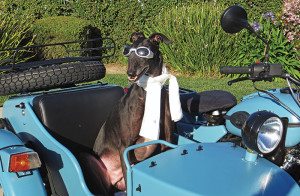
As long as you appreciated its limitations, that is. Designed for low-cost, stone-simple maintenance and longevity, not velocity, the 2012 Ural T’s air-cooled, 749cc boxer twin and 4-speed transmission slowly propelled the rig up to a max of about 60 mph, and at anything over 50 it bobbed and weaved like Roger Rabbit was at the controls. It was too slow and scary to ride on the Interstate, depended too heavily upon the bike’s sole disc brake in front and drank premium fuel like a racebike, averaging just 23.4 mpg.
What a difference a couple years can make.
“Two and a half years ago, we decided we needed to do something more significant than changing the color combinations…so we made the bike lighter, faster, more responsive, more fuel efficient, better in handling and braking,” said Ilya Khait, Ural president and CEO. “New Urals maintain our signature classic charm, ruggedness and unpretentious character. At the same time, performance-wise these bikes got closer to what riders expect from a modern-day motorcycle.”
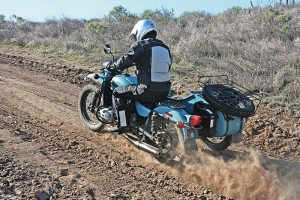
Ural went private in 1998, and regular investments in R&D, manufacturing and design have led to many refinements in the years since. But 2014 will be remembered as a watershed model year. The Keihin carburetors are gone, replaced with an electronic fuel injection system designed for Ural by Michigan-based Electrojet, which specializes in bolt-on EFI systems for carbureted engines. Ural also upgraded the drum brakes on the sidecar and rear of the motorcycle to disc, and replaced the ineffective friction-style steering damper with an adjustable hydraulic unit.
There’s a lot more, but these changes alone have transformed the machine from a quirky plaything into a practical daily driver and less-limited touring rig. The closed-loop fuel injection, a larger airbox and new cam profiles have bumped horsepower to a claimed 41 from 40, and torque from 38 lb-ft to 42. Compared to our previous rig, though, it feels like a bigger power increase, enough to bring the throttle response and top speed into usable territory. It’s still not ready for cross-country on the I-40—at least not with me—but our 2014 Ural Gear-Up test rig easily held a steady 65 mph on level roads, and I took it up to its new recommended 70 mph top-speed on local freeways more than once without puckering the tractor seat (much). Our fuel economy jumped to a 29.5 mpg average despite wringing its neck and carrying a passenger or 90 pounds of ballast in the sidecar at all times; Ural says it should deliver 31-37 mpg.
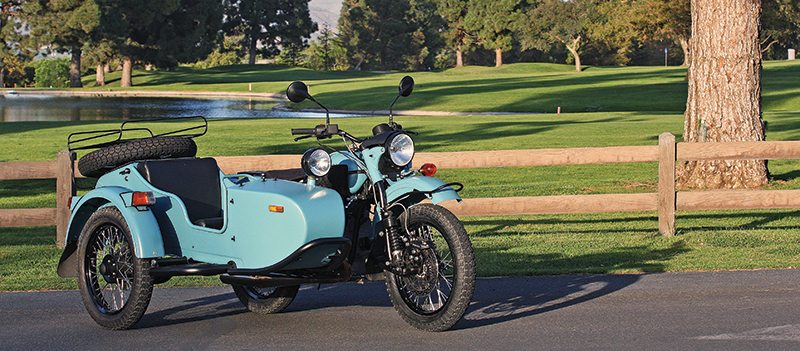
The rig still accelerates slowly and was relegated to the slow lane on hills, even slight inclines, and you need to plan passes well in advance. But the Gear-Up actually purrs along quite smoothly at highway speed, with the usual valve train clatter from the flat opposed OHV twin, but not much more mechanical noise. The German-made 4-speed transmission does shift stiffly and noisily, the engine needed some warm-up time at startup and had a tendency to hesitate and pop quietly at times, but we received it with five miles on the clock, and as the miles accumulated it smoothed out and quieted down a bit. Ural and Electrojet will be providing dealers with updates for the programmable fuel injection mapping as they become available, too.
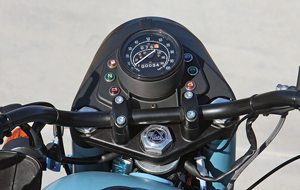
Those higher speeds wouldn’t be possible without the rig’s improved handling, which is primarily attributable to the new steering damper. Due to the inertia of the sidecar, sidehack rigs have a tendency to push to the left when you roll off the throttle and pull right when you roll on. As the rider corrects for this at the bars, if the oscillation isn’t damped out it can make the rig yaw and weave, particularly if the car’s toe-in isn’t set just right. The new 16-position steering damper is easily adjusted to a good compromise between steering effort and stability for the load, and takes all of the terror out of the rig’s handling that the friction damper did not. It doesn’t eliminate the need to learn how to “drive” a sidecar—the Ural folks can steer you toward several good sources for that info—but it does make it reasonable to drive at speed and a lot more confidence-inspiring for newbies.
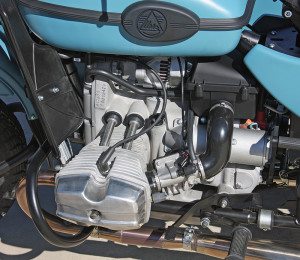
Especially since it stops now, too. With the old drum setup on the sidecar and rear wheel of the motorcycle, there was so much brake pedal travel you had to bury your shin in the right intake manifold before the rig would begin to slow. Once they’re properly adjusted, the new disc brakes on those wheels only require slight pedal pressure to apply fully and have much better feel. You still need to use them in combination with the big single front disc to stop the rig quickly (and much practice is advised to prevent heart-stopping skids on the skinny and long-wearing Duro tires), but the discs are a vast improvement, particularly (I imagine) in the wet.
They certainly do nicely in the dirt. The Gear-Up is the first two-wheel drive model we’ve sampled, so naturally I headed for some dirt roads and the local quarry as soon as the bike was broken-in. 2WD Urals are known for their ability to slog through snow and mud, a must for mobilizing the Soviet military in WWII, as well as basic transport in largely unpaved Siberia. Like the one-wheel-drive models, levers for reverse gear and the easier-to-use parking brake are down on the right. The Gear-Up and top-line Patrol models add a third lever for engaging the exposed shaft that drives the sidecar wheel. Once in 2WD, the Gear-Up will relentlessly plow through loose dirt, sand and uphill climbs as long as you give it plenty of throttle. Since both driven wheels are pointing straight ahead, the front wheel tends to push in 2WD, but it will turn if you get some of your weight over the front wheel. It’s not going to win any motocross races, but the Gear-Up will get you into and out of some pretty remote spots for camping, hunting or fishing, or even to the tip of South America if you’re not in a hurry.
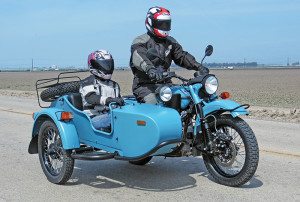
To better cope with this kind of rugged use, for 2014 the wheel hubs have been redesigned with replaceable, hardened drive-spline flanges instead of cast-in splines, and have new sealed bearings with protective dust seals. The final drive has also been redesigned, a former weak link in the drivetrain.
We didn’t weigh the Gear-Up, but Ural says its lost nine pounds in the revamp, which also includes a new front engine cover with a standard spin-on oil filter, a new weather-tight wiring harness with an electronic service port and redesigned dashboard that adds fuel warning and engine management lamps. The leading-link fork and triple clamps are stronger, and the machines get new kneepads and badging.
All five Sachs shock absorbers—two in front, two in back and one on the car—are identical on the Urals. Carry a spare one and you’re ready for some rough roads. The heavily spoked wheels and tube-type tires are also the same all around, and the Gear-Up comes with a spare (you have to transfer the brake disc from the disabled wheel to use it). All of the regular maintenance can be performed by a handy owner, and the Gear-Up comes with the largest standard toolkit we’ve ever seen, not to mention a bicycle pump and a folding shovel to dig yourself out if reversing won’t do the job. There’s also an adjustable spot lamp, electrical accessory outlet and jerry can mounted on the sidecar, engine guards and bash bars up front, a luggage rack, lower wind deflectors for the rider and rubber floor mats in the sidecar/trunk. It’s ready for the boonies or just the local burger joint.
Any number of aftermarket outfits will sell you a bolt-on sidecar or finished conversion. Ural USA is the only one importing OEM motorcycle-sidecar combinations. Once you master the brakes, steering inertia and the tendency of the chair to lift, you can enjoy all the fun and convenience of a three-wheeler that holds itself up at stops, even tackle some pretty rough roads on a Gear-Up. Just set your GPS to avoid the Interstate.
2014 Ural Gear-Up
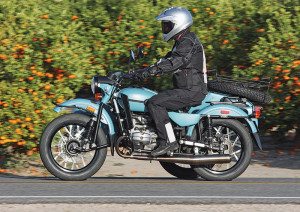
Base Price: $15,999
Warranty: 2 yrs., unltd. miles
Website: imz-ural.com
Engine
Type: Air-cooled, longitudinal flat opposed-twin
Displacement: 749cc
Bore x Stroke: 78.0 x 78.0mm
Compression Ratio: 8.6:1
Valve Train: OHV, 2 valves per cyl.
Valve Insp. Interval: 625, then every 3,125 miles
Fuel Delivery: Electrojet EFI
Lubrication System: Wet sump, 2.2-qt. cap.
Transmission: Cable-actuated dry clutch, 4 forward speeds, 1 reverse
Final Drive: Shaft, 4.62:1; w/ engagable sidecar wheel
Electrical
Ignition: Electronic
Charging Output: 560 watts max.
Battery: 12V 20AH
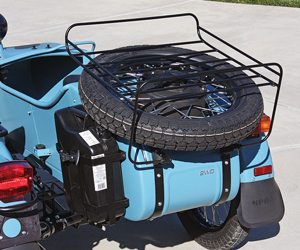
Chassis
Frame: Tubular-steel double cradle & swingarm
Wheelbase: 58.0 in.
Rake/Trail: 23 degrees/2.4 in.
Seat Height: 32.0 in.
Suspension, Front: IMZ leading-link fork w/ dual Sachs shocks, adj. for spring preload
Rear: Dual Sachs shocks, adj. for spring preload
Sidecar: Single-sided swingarm w/ Sachs shock, adj. for spring preload
Brakes, Front: Single 295mm floating disc w/ Brembo 4-piston opposed caliper
Rear: Single 256mm disc w/ Hayes big-bore 1-piston floating caliper
Sidecar: Single 245mm disc w/ Brembo 2-piston floating caliper
Wheels, All: Spoked aluminum, 2.5 x 19 in.
Tires, All: Duro HF-308, 4.0 x 19 in.
Claimed Dry Weight: 730 lbs.
Claimed Load Capacity (incl. fluids): 595 lbs.
GVWR: 1,325 lbs.
Performance
Fuel Capacity: 5.0 gals., warning light on last 1.0 gal.
MPG: 91 PON min. (low/avg/high) 29.4/29.45/29.5
Estimated Range: 148 miles
Indicated RPM at 60 MPH: NA
(This article Juggernaut was published in the June 2014 issue of Rider magazine.)

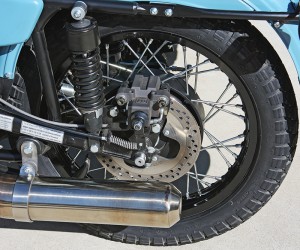
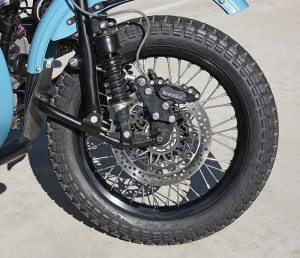







Being the happy owner and daily rider of a 2013 Ural Patrol I have to take exception to some of the statements in the article on the 2014 Ural. While there are no doubt improvements in the 2014 due to the fuel injection and disk brakes the statements regarding the “terror” related to the steering and the top speed of “60” are grossly misleading and untrue. Similarly, the brakes, while greatly improved with disks, will stop the bike very handily if you know how. The top speed on my 2013 is also about 70, and it has done better. But it is really comfortable at 55 to 60. Which is really fast enough if you want to enjoy the scenery and the environment.
Riding with a side car requires a different skill set. The steering is just that, you steer, you don’t lean and you don’t counter-steer. You turn the front wheel to point the way you want to go. You also learn to shift your weight to help keep the sidecar on the ground. You can also show off by “flying” the sidecar which always gets attention, particularly from your passenger.
Riding a Ural requires a different mind set as well. It is basically an updated 1939 BMW with a sidecar. As such it draws attention where ever you go. “What is it? “Where did you get it?” “How old is it?” “Does your wife ride in it?” “It is so neat”. “Amazing! from Russia? Really?” And best of all, you see smiles! Old people, young people, women, men, kids, everyone. Thumbs up! Waves – even from people not riding motorcycles! Try to get any of that wearing black leather on a Harley.
I have to agree with Cliff. (2007 Gear-up). Riding a Ural is just different than any other bike, not better or worse. I have owned an FJR and to compare that to a Harley soft tail one could call the Harley ride shear terror, but it’s really just different. To take a ural on a camping trip will change the way you look at travel.
ps. Mine was a daily driver year round, never had so much fun driving to work in snow storms.
Following a last-generation Ural up a steep slope in deep snow, I was consistently able to pull a higher gear on the new bike or hold a single gear through sections that required multiple shifts on the old model.